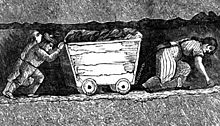A corf (pl. corves) also spelt corve (pl. corves) in mining is a wicker basket or a small human powered (in later times in the case of the larger mines, horse drawn) minecart for carrying or transporting coal, ore, etc.[1] Human powered corfs had generally been phased out by the turn of the 20th century, with horse drawn corfs having been mostly replaced by horse drawn or motorised minecarts mounted on rails by the late 1920s. Also similar is a Tram, originally a box on runners, dragged like a sledge.

Origin of term
edit1350–1400; Middle English from Dutch and German Korb, ultimately borrowed from Latin corbis basket;[1] cf. corbeil.
Survivors
editThe National Coal Mining Museum for England has a hazel basket type Corf from William Pit near Whitehaven.[2]
See also
editReferences
edit- ^ a b Jamieson, John (1840). An Etymological Dictionary of the Scottish Language (2 ed.). W. Tait. p. 245.
- ^ "Tools of the Trade". National Coal Mining Museum. Retrieved 28 March 2020.
External links
edit- The dictionary definition of corf at Wiktionary